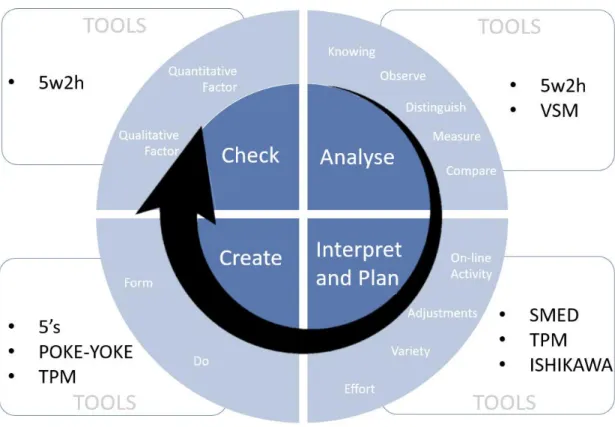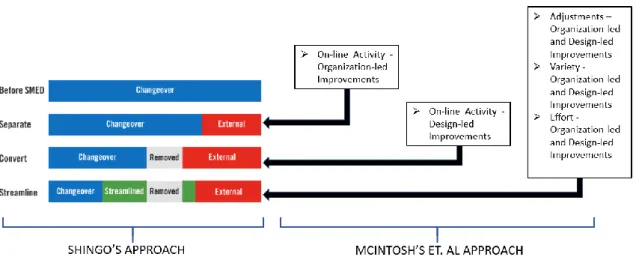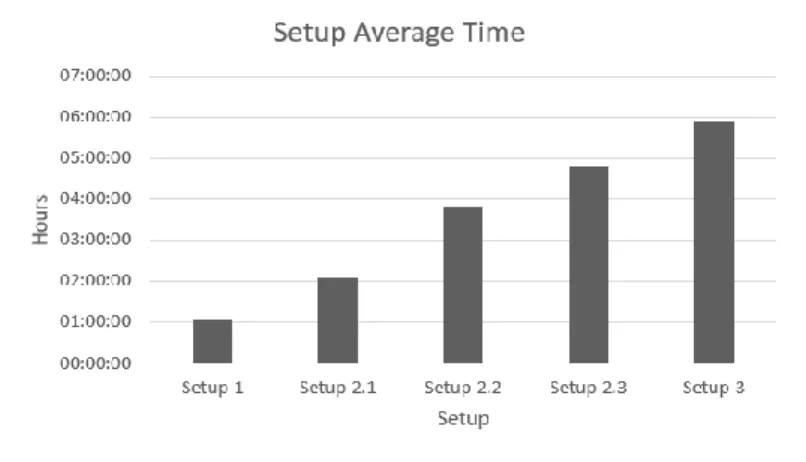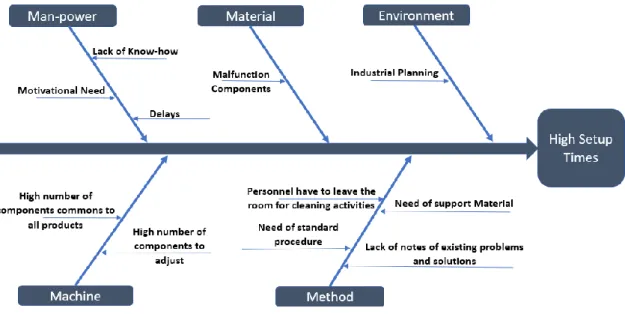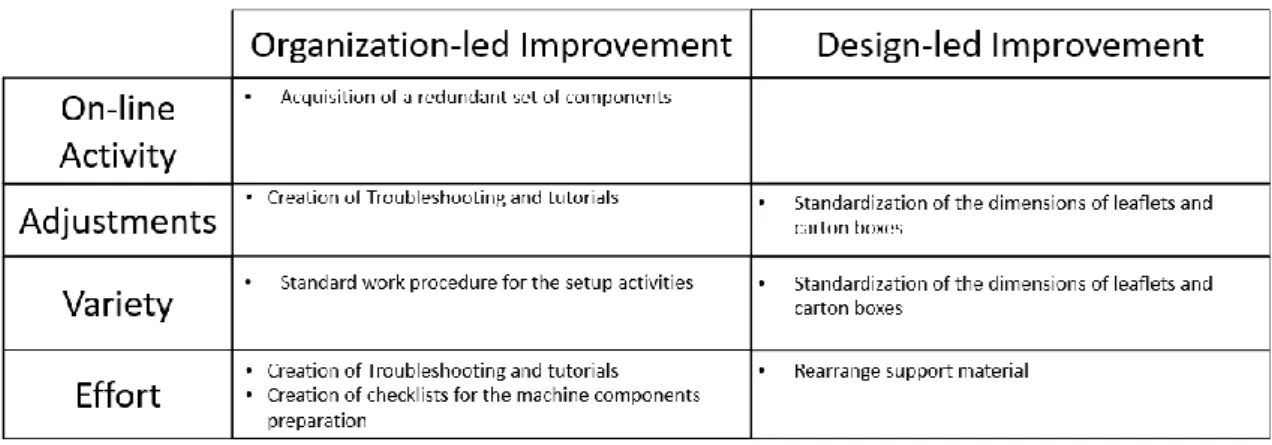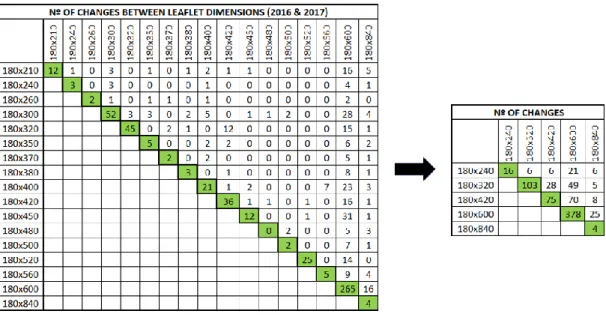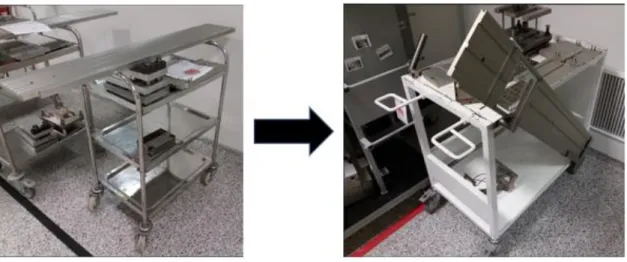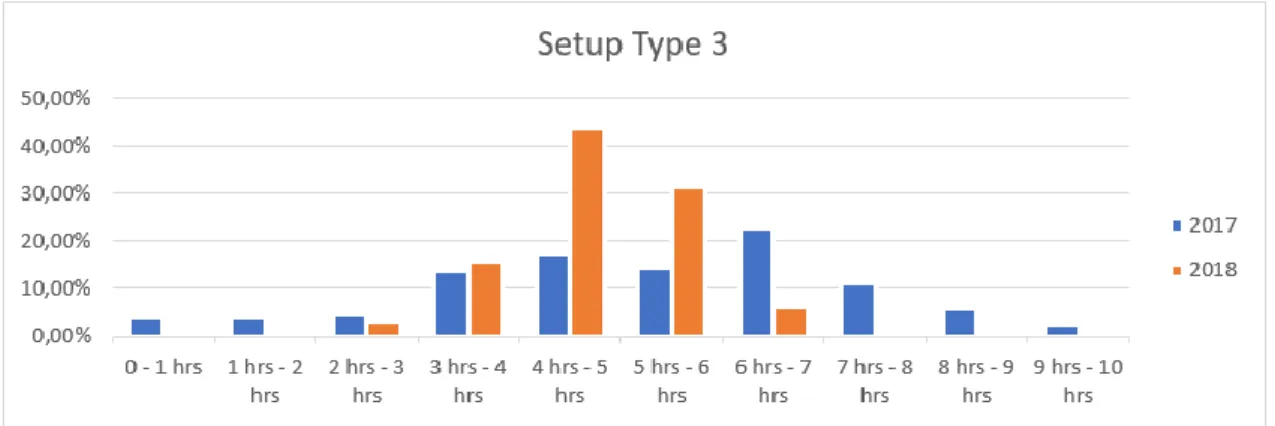ENGENHARIAS, TECNOLOGIA, GESTÃO E TURISMO
ENGINEERING, TECHNOLOGY, MANAGEMENT AND TOURISM
INGENIERÍA, TECNOLOGÍA, ADMINISTRACIÓN Y TURISMO
mill
e
nium
37
Millenium, 2(8), 37-52.
APLICAÇÃO DAS METODOLOGIAS LEAN NA REDUÇÃO DOS TEMPOS DE SETUP NA INDÚSTRIA FARMACÊUTICA
APPLICATION OF LEAN METHODOLOGIES IN THE REDUCTION OF SETUP TIMES IN THE PHARMACEUTICAL INDUSTRY
APLICACIÓN DE LAS METODOLOGÍAS LEAN EN LA REDUCCIÓN DE LOS TIEMPOS DE SETUP EN LA INDUSTRIA
FARMACÉUTICA
André Gil Curado
1António Abreu
1, 21
Instituto Superior de Engenharia de Lisboa, Lisboa, Portugal
2
CTS - Uninova – Instituto de Desenvolvimento de Novas Tecnologias, Caparica, Portugal
André Gil Curado - andregcurado@gmail.com | António Abreu - ajfa@dem.isel.ipl.pt
Corresponding Author
André Gil Curado
Rua Ilha da Graciosa nº 117 3ºB Carcavelos 2775-803 Cascais
andregcurado@gmail.com
RECEIVED: 17th October, 2018 ACCEPTED: 05th December, 2018
Curado, A. G. & Abreu, A. (2019). Application of lean methodologies in the reduction of setup times in the pharmaceutical industry. Millenium, 2(8), 37-52.
DOI: https://doi.org/10.29352/mill0208.04.00220
m
38
8
RESUMO
Introdução: A competitividade internacional acentuada motivada pela globalização com o objetivo de alcançar um público que
cada vez se nota mais exigente, faz da diminuição de custo e aumento da qualidade uma necessidade primária transversal a qualquer setor. A indústria de medicamentos genéricos onde o preço é a arma principal no alcance do consumidor não é exceção e cria uma forte necessidade na aplicação das metodologias Lean com o intuito de otimizar a produção.
Objetivos: Reduzir os tempos de setup mediante a aplicação de metodologias Lean estruturado por um modelo proposto. Métodos: No decorrer deste estudo foi revista a bibliografia referente à origem e várias metodologias Lean, sendo proposto um
modelo de aplicação. A implementação teve por base um estudo detalhado das mudanças resultando num conjunto de propostas de solução dedicados aos principais problemas aplicando diversas ferramentas Lean.
Resultados: Redução dos tempos de mudança na ordem dos 20% e número de espera na ordem dos 24,5% no espaço de 3
meses.
Conclusões: A aplicação das metodologias Lean revelou uma grande utilidade na identificação das causas e na criação de
soluções. A implementação de este modelo, ainda que numa fase inicial, permitiu não só redução dos tempos de mudanças, mas como outras melhorias como a diminuição do número de esperas. Contudo, esta aplicação, por estar inserido numa indústria farmacêutica contempla alguns procedimentos que não podem ser alterados limitando os tempos de mudanças.
Palavras-chave: Lean; Indústria Farmacêutica; Ferramentas Lean; SMED
ABSTRACT
Introduction: The strong international competitiveness motivated by globalization with the purpose of reaching an increasingly
demanding public, makes cost reduction and quality increase a primary need across all sectors. The generic drug industry where price is the primary weapon in consumer reach is no exception and creates a strong need in the application of Lean methodologies to optimize the production.
Objectives: Reduce of changeover times by the application of lean methodologies structured by a proposed model.
Methods: This study started with a review of the bibliography of the Lean’s origin and the several methodologies ending with
the application of a proposed application model. The implementation was based on a detailed study of the setups resulting in a set of solution proposals dedicated to the main problems applying several lean tools.
Results: Reduction of change times by 20% and waiting times by 24.5% within 3 months.
Conclusions: The application of Lean methodologies revealed a great utility in the identification of causes and in the creation of
solutions. The implementation of this model, although in an initial phase, allowed not only reduction of the times of changes, but also other improvements such as the reduction of the number of waits. However, this application, due to being inserted in the pharmaceutical industry, is limited by some procedures that cannot be changed.
Keywords: Lean; Pharmaceutical Industry; Lean Tools; SMED
RESUMEN
Introducción: La competitividad internacional acentuada motivada por la globalización con el objetivo de alcanzar un público
que cada vez se nota más exigente, hace de la disminución de costo y aumento de la calidad una necesidad primaria transversal a cualquier sector. La industria de medicamentos genéricos donde el precio es el arma principal en el alcance del consumidor no es una excepción y crea una fuerte necesidad en la aplicación de las metodologías Lean con el fin de optimizar la producción.
Objetivos: Reducir los tiempos de setup mediante la aplicación de metodologías lean estructurado por un modelo propuesto. Métodos: En el transcurso de este estudio se revisó la bibliografía referente al origen y a las varias metodologías Lean, siendo
propuesto un modelo de aplicación. La implementación se basó en un estudio detallado de los cambios resultando en un conjunto de propuestas de solución dedicadas a los principales problemas aplicando varias herramientas lean.
Resultados: Reducción de los tiempos de cambio en 20% y tiempos de espera en 24,5% en el plazo de 3 meses
Conclusiones: La aplicación de las metodologías Lean reveló una gran utilidad en la identificación de las causas y en la creación
de soluciones. La implementación de este modelo, aunque en una fase inicial, permitió no sólo reducir los tiempos de cambio, sino como otras mejoras como la disminución del número de esperas. Sin embargo, esta aplicación, debido por estar inserta en una industria farmacéutica, tiene algunos procedimientos que no pueden ser alterados limitando los tiempos.
Curado, A. G. & Abreu, A. (2019).
Application of lean methodologies in the reduction of setup times in the pharmaceutical industry. Millenium, 2(8), 37-52.
DOI: https://doi.org/10.29352/mill0208.04.00220
m
8
39
INTRODUTION
Today we are in presence of a global market created by the evolution of transports and communications ways. Nowadays, customers demand a wide range of products delivered with high quality, quicker response times and sold at reasonable prices. The importance of short changeover times has become critical to rapidly respond to changes in customer requirements (Sullivan, McDonald, & Van Aken, 2002) and to be able to switch from one product to another, thus putting the enterprise in front of other competitors (Wallace & Choi, 2011). The benefits of the setup reduction are the increase of flexibility by conducting more changeovers and reducing lot size, increase bottleneck capacities in order to maximize the line availability and minimization of costs (Van Goubergen & Van Landeghem, 2002).
Lean Manufacturing offers the proper tools in order to reduce the waste inside and between the different processes while being able to increase the value of the product (Karam, Liviu, Cristina, & Radu, 2018). This idea was initiated in the post-war period by Taiichi Ohno and his peers and initially applied in Toyota, an automotive industry company. Nowadays it is seen with great interest by any field due to the excellent results demonstrated in Toyota (Jeffrey K. Liker, 2006). Lean thinking aims, within a continuous improvement cycle, to optimize resources and processes by reducing all activities that do not add value or are not fundamental to achieve this goal. This concept uses several methodologies that have been developed over the years and make this goal tangible, examples of these methodologies are Total Productive Maintenance, SMED, Value Stream Mapping or 6-sigma (Rauch, Damian, Holzner, & Matt, 2016).
The need of reducing wastes is increasingly important in production lines with a wide variety of product (B. S. Kumar & Abuthakeer, 2013) and generic-product industries are no exception. In this work it is presented an example carried out in the pharmaceutical industry in a company nationally leader in the production of generic drugs. This application of lean methodologies has the purpose of reducing the change-over time. In this analysis, is proposal for an implementation model which, structured in a PDCA cycle, applies several Lean methodologies to identify causes and define the best practices to reduce change-over times.
A packaging line setup belonging to the pharmaceutical plant, has unique characteristics compared with the setup of other traditional assembly lines (Bevilacqua, Ciarapica, Mazzuto, & Paciarotti, 2013). This article, using Shingo and McIntosh methods, seeks to answer the questions, what precautions needs to be taken in this industry? how can waste be identified? What lean methods can we use? How to fight the wastes found in the plant? Showing step by step an example of a study case. This article is initiated with the historical background of Lean thinking presenting then the Shingo and McIntosh methods on reducing setup time and the proposed method that is applied on the case study demonstrated.
1. HISTORICAL BACKGROUND OF LEAN THINKING
The designation of Lean Thinking was given by John Krafcik in 1988 in the research "Triumph of the Lean Production System" in a MIT program called International Motor Vehicle Program where James Womack was the researcher director. James Womack and Daniel Jones after several years studying the success of Japanese companies, described the emergence and evolution of this model of management in two publications “The machine That Changed the World” and “Lean Thinking” (Pinto, 2014). Since then, this term is used worldwide and progressing from the automotive industry to several areas such as tourism, medicine or construction industry.
The Lean Thinking concept was born in Japan in the 1940s by Taiichi Ohno, an industrial engineer at Toyota. In a post-war time with the country in a severe crisis, where there were great needs and scarce resources, Ohno finds himself obligated to take action by putting his own ideas into practice (Womack, 1990).
This new approach has revolutionized the way the organization thinks and behaves, Lean thinking is not just a set of practices but a profound cultural change, believing in a change that sustains the dynamics and the process of continuous improvement. Taiichi Ohno has revolutionized the industry in three fundamental points, people, processes and solutions (Pinto, 2014).
It took more than 20 years of effort to fully implement this whole set of ideas into Toyota's entire supply chain. By the 1990s, Toyota already offered such a vast product range as General Motors and as a Lean producer it only took half the time and effort to design a new car compared to other brands (Womack, 1990).
The validity of Lean principles and solutions is corroborated by the success of companies such as Toyota Motors Corporations, which reached the top of the automotive industry in 2007 by dethroning General Motors from the top position who was since 1930 the largest company in this industry (Schmitt, 2017).
Lean thinking is a management philosophy for maximizing value through the consistent reduction of waste. To do so, it uses a set of methodologies, techniques and tools oriented to the simplification and optimization of processes, removal of activities and resources that do not add value and the involvement of all members, in the constant improvement of the organizations performance (Rauch et al., 2016). These methods, techniques and tools have several applications having been developed over the decades in several countries by different companies, examples of these methodologies are 5’s, SMED, 6-sigma or Total Productive Maintenance.
Curado, A. G. & Abreu, A. (2019). Application of lean methodologies in the reduction of setup times in the pharmaceutical industry. Millenium, 2(8), 37-52.
DOI: https://doi.org/10.29352/mill0208.04.00220
m
40
8
2. REDUCING SETUP TIME
Changeover time is the period between the last good product produced and the first of the next production (Karam et al., 2018). Rapid tool change techniques were introduced and developed for the first time by Shingeo Shingo in the 1950s which, after 19 years, examining this methodology reported his work in the book "A revolution in manufacturing: the SMED system" (Dillon & Shingo, 1985).
During the following decades, the reduction of setup times continued to be addressed by several Japanese companies such as the case of Mitsubishi Heavy Industries Ltd. and M Electric Japan appearing numerous publications. It was only in the 1980s that this methodology was extended to European industries in part because of the success of the Toyota Production System (Sohani, 2011).
2.1 MODEL OF THE CASE STUDY
In his work, Shingo points out the need of a structure or a methodology that guides the improvement techniques. The proposed model aims to detail a cycle based on the Deming’s PDCA cycle that structures an improvement application in the scope of reduction of the change-over times. This proposal is based on the reports and observations of two major publications, “Shingo's Revolution in Manufacturing: The SMED System” and S. Culley et al. “Improving Changeover Performance” in which the authors review Shingo's work and propose organization-led and design-led solutions.
This methodology is structured in 4 phases: “Analyze”, “Interpret and Plan”, “Create” and “Check” (Figure 1).
Analyze - The first phase of the cycle is to analyze in detail all the elements from the characteristics of the industry in which it is inserted up to the details of each activity. This cycle is based on 5 points, “Knowing”, “Observe”, “Measure”, “Distinguish” and “Compare”. “Knowing” refers to know all the steps of a changeover and to understand the logic behind it. The first step would be to define the concept of "value" and understand it is chain, defining the "value" may present the priorities explaining the precautions that need to exist in a setup. The second point “Observe” is to know the steps in detail, to develop this point, it is necessary to monitor and observe the changes, in the observe phase, filming may be appealing. One methodologies that can be used is 5w2h by questioning and understanding all aspects of a change. It is important to observe the sequence of operations pointing out which tasks are handled, when and by whom, the sequence of operations can be quite significant in the performance of a change (Culley, Owen, Mileham, & McIntosh, 2001). Sometimes the setups between the various products are different having different times. This point, “Distinguish”, differentiates the several characteristics. “Measure” is one of the important points, measuring and recording all the components of a setup. The “Compare” phase is the comparison between measurements. It conveys the current state, tells the progress that is being made and allows to analyze the impact of the different factors involved in a setup.
Interpret and Plan - The interpretation of collected data allows to identify the gaps in the processes, exposing the causes and setting a way to follow in the reduction of waste. A tool widely used in this analysis is the Ishikawa diagram, a tool which helps identify the causes of the problems. This phase aims to create a plan by the improvement’s opportunities identified with the analysis. The interpretation of the difficulties allows at in this point, the creation of solutions and indicates the plan to follow. SMED and TPM are two major tools that can be used in planning the change-over times reduction strategy.
Create - This point consists in putting into practice the plan created earlier to fight the problems identified. The creation of solutions involves two elements:
Do - put into practice all physical solutions defined to fight the gaps identified. Methodologies as the application of 5's or Error Proofing can be used in this phase to support the streamlining of the external and internal activities.
Form - putting into practice non-physical solutions such as training, which have a great impact on performance (Culley et al., 2001).
Check - Like the last point of a PDCA cycle, this point verifies quantitatively, the consequences of the applications as the case of times recorded, or qualitatively as in the case of the satisfaction of the employees which is significantly increased with the successful implementation of Lean applications like 5s or SMED (Boztinaztepe & Canan, 2008).
Curado, A. G. & Abreu, A. (2019).
Application of lean methodologies in the reduction of setup times in the pharmaceutical industry. Millenium, 2(8), 37-52.
DOI: https://doi.org/10.29352/mill0208.04.00220
m
8
41
Figure 1 - Stages of the Case Study
3. LEAN TOOLS
According to some authors, SMED should be accompanied by other methods such as the application of 5s (Sohani, 2011) or TPM such as the use of OEE indicator (Karam et al., 2018). In this study case 6 different tools are used to facilitate the analysis of each step (Figure 1).
3.1 5w2h
5w2h is an introductory method of clarifying problems for the purpose of determining not only the root of the cause, but also facilitating the implementation of corrective and preventive actions (Nagyova, Palko, & Pacaiova, 2015). During the “Analyze” stage, this tool is used to study the setups.
3.2 Ishikawa Diagram
This method was developed by Ishikawa in the 1950s. Through this tool it is possible to analyze the possible causes of an effect such as a problem, a defect or a waste (Gwiazda, 2006). This method is used to identify the causes of the problems and points out solutions in the “Interpret and Plan” phase.
3.3 Value Stream Mapping
The Value Stream Mapping consists of recording the set of activities that create and deliver value to the customer and other stakeholders (Seth & Gupta, 2005). This methodology is used in the “Analyze” step to study the setup process.
3.4 SMED
The main tool used in this work to reduce setup time is SMED. The SMED approach is used in the phase “Interpret and Plan” to identify the activities that can be done while the machine is running. Single Minute Exchange of Die method was introduced by Shingo and consists of actions that aim at the systematic reduction of setup times to maximize the use of the components (Karam et al., 2018). The core of SMED is to reduce the time by performing as many activities as possible while the equipment is running and to simplify the remaining steps. The SMED method’s objective is to systematically reduce setup times to maximize the use of the components. Shingo presented the SMED methodology with four stages that support the reduction of setup time: the preliminary stage where internal and external are not distinguished; separate internal and external setup activities, convert
Curado, A. G. & Abreu, A. (2019). Application of lean methodologies in the reduction of setup times in the pharmaceutical industry. Millenium, 2(8), 37-52.
DOI: https://doi.org/10.29352/mill0208.04.00220
m
42
8
internal setup activities to external ones; and streamline external and internal activities (Dillon & Shingo, 1985). The direct consequences of reducing changeover are reducing batch size, increasing flexibility, and reducing costs (Karam et al., 2018). Although SMED is known as a successful method for more than twenty five years, (Ferradás & Salonitis, 2013) in his work, McIntosh et al. argue that the Shingo methodology, despite being supported by many examples, might not be the most efficient way. The authors refer that is given emphasis to low cost organization improvements and little attention to design changes. This practice can lessen the use of other important improvement options. McIntosh et al. affirm that improvement which frequently involves design changes that alter the nature of changeover tasks, (or eliminating some tasks) can have an equal or a greater result (McIntosh, Culley, Mileham, & Owen, 2000). In “Improving Changeover Performance”, McIntosh at al. present organization-led and design-led solutions to overcome the changeover difficulties (Table 1) (Culley et al., 2001).
Table 1 - Improvement Techniques Source:(Culley et al., 2001) (adapted)
Shingo and McIntosh approaches lead to the minimization of change-over activities but with different perspectives, both methods are represented in the Figure 2.
Curado, A. G. & Abreu, A. (2019).
Application of lean methodologies in the reduction of setup times in the pharmaceutical industry. Millenium, 2(8), 37-52.
DOI: https://doi.org/10.29352/mill0208.04.00220
m
8
43
Figure 2 - Shingo and McIntosh approaches on setup time reduction
In Shingo’s book, he demonstrates how the results of the SMED application go beyond reducing change times. Practitioners of this method can reap benefits such as increased productivity, increased operator performance, as well as quality and safety (Dillon & Shingo, 1985).
3.5 Total Productive Maintenance
TPM is a management approach that seeks the constant elimination of all forms of waste existing in the productive and administrative areas of the company. This concept was created in the 1960s by Nakajami in Japan and was initially developed to support the maintenance of the equipment and which later extended it is area of intervention to the whole process (Williamson, 2015). This methodology relies upon 6 elements: Productivity, Morale, Quality Delivery Safety and Cost (J. Kumar, Soni, & Agnihotri, 2014). This tool is used in the stage “Interpret and Plan” to analyze the productivity status translating the OEE values, and in the Create stage training the personnel to perform tasks.
3.6 5's
The 5’s is a lean method and an improvement system adopted to reduce waste, clean the workspace and improve productivity. It is usually used to facilitate other lean methods. To this end, 5s aims to maintain order in the workplace and uses visual management to increase operational results (Al-Aomar, 2011). During the create stage, 5’s techniques were applied to standardize the setup process.
3.7 Error-proofing
Error-proofing methods were introduced by Shingeo Shingo in Japan in the 1960s and are based on the identification and prevention of errors or defects in processes. These methods have several denominations also known as mistake proofing or fool proofing and are often covered in their Japanese designation poka-yoke, meaning "error-proof system" (Tommelein & Ballard, 1999). This method is used in the “Create” phase to create mechanisms to prevent errors.
4. CASE STUDY
The implementation was performed on one of the lines of the packaging department of a pharmaceutical company that produces a wide range of generic drugs for domestic and international market. This line has 2 machines, the blister machine and the packing machine and has team of 6 people working in shifts of two people per shift.
4.1 Analyse
The application of the model was initiated with the definition of value and the identification of the value chain of the project in question (Figure 3). In this case, the "value", regarding the industry in which these changes are inserted, is defined by the modification of the necessary components in a fast way never jeopardizing the health of employees or customers.
Curado, A. G. & Abreu, A. (2019). Application of lean methodologies in the reduction of setup times in the pharmaceutical industry. Millenium, 2(8), 37-52.
DOI: https://doi.org/10.29352/mill0208.04.00220
m
44
8
Figure 3 - Value Stream Map Packaging Product Change-over
The second step in this stage consisted in collecting and analyzing the data and the characteristics of each change and the production line. In total, 37 changes were observed, divided into 5 different types of setups according to their nature and named setups type 1, 2.1, 2.2, 2.3 and 3. These setups have different mean times depending in their complexity.
Figure 4 - Average Time of the different setups
This packaging line has 2 machines, the blister line to pack the pills into blisters and the cartoner to pack the blisters into carton boxes. Both machine have the same setup process but with different natures. In this phase, the theoretical and the real times of each activity of the process were analyzed and compared (Figure 5).
Curado, A. G. & Abreu, A. (2019).
Application of lean methodologies in the reduction of setup times in the pharmaceutical industry. Millenium, 2(8), 37-52.
DOI: https://doi.org/10.29352/mill0208.04.00220
m
8
45
Figure 5 - Time of each stage of a setup 3
The history of the changeovers was also analyzed in the years 2016 and 2017, noting the number of changes, the dispersion of change times, the products, most frequent products, as well as the number of changes between each size of box and leaflet and number of problems during the setups (Table 2).
Table 2 - Nº of changes between leaflet dimensions during 2016 / 2017
4.2 Interpret and Plan
With the first point of the cycle completed, an elaborate interpretation of causes and an improvement plan was defined. The first step in this stage was the analysis of the main causes using a Lean technique called cause-effect diagram explored by Ishikawa (Figure 6). 0,00 20,00 40,00 60,00 80,00 100,00 120,00 Clo si n g P ro d u cti o n Di sas se mb le Co m p o n en ts Cle an in g A ss emb le Co m p o n en ts A d ju stm en ts Clo si n g P ro d u cti o n Di sas se mb le Co m p o n en ts Cle an in g A ss emb le Co m p o n en ts A d ju stme n ts
Setup 3 - Blister Machine Setup 3 - Cartoner
Min
u
tes
Setup 3 - Stage Times
Theoretical Real
Curado, A. G. & Abreu, A. (2019). Application of lean methodologies in the reduction of setup times in the pharmaceutical industry. Millenium, 2(8), 37-52.
DOI: https://doi.org/10.29352/mill0208.04.00220
m
46
8
Figure 6 - Ishikawa Diagram of the causes of High Setup Times
With the identification of the main problems, the difficulties were interpreted and by the application of Lean methodologies, 6 solutions were defined:
- Application of 5’s methodology: Work Standardization - Create a standard work procedure for the setup activities including a new element. The purpose of this application is to create a standard procedure of the best practice. This new practice relies on executing activities in parallel with the help of a third element.
- Application of SMED methodology: Acquisition of a redundant set of components - The acquisition of redundant set of some components externalize the activity of their cleaning.
- Standardization of the dimensions of leaflets and carton boxes - Reducing the number of different dimensions, without creating any kind of constraint to the costumer, reduces the number of adjustments in the setup. By choosing the dimensions that create the lowest number of stoppages during the production, productivity will increase.
- Use of Total Productive Maintenance Morale methods: Creation of Troubleshooting and tutorials - train the personnel to perform all the functions needed in a setup including adjustments or small maintenance activities.
- Poka-yoke application: Rearrange support material – creation of mechanism in the support material to help the transportation of machine components.
- Application of Error Proofing methodology: Creation of checklists for the preparation of machine components - Create check lists to don’t miss any important part creating a set of components needed in the line.
In the table 3 it is presented, according to the McIntosh’s SMED approach, the solutions proposed and what difficulty it aims to reduce. The “Creation of Troubleshooting and Tutorials” and the “Standardization of the dimensions of leaflets and carton boxes” do not aim specifically to reduce the time consumed in adjustments but by reducing the effort in performing adjustments activities and by reducing the variety of the dimensions it is expected to short the “Adjustments” activities.
Curado, A. G. & Abreu, A. (2019).
Application of lean methodologies in the reduction of setup times in the pharmaceutical industry. Millenium, 2(8), 37-52.
DOI: https://doi.org/10.29352/mill0208.04.00220
m
8
47
Table 3 - Improvements presented to each difficulty
4.3 Create
4.3.1 Standard work procedure for the setup activities
This new practice relies on the execution of the cleaning activities in parallel and in the cooperation between the personnel to perform the activities in a quicker way. The Figure 7 represents a setup before the new approach where each staff cleans their own machine and then they clean the components.
Figure 7 - Gantt Chart of a setup before the procedure standardization
In Figure 8, a setup is presented to observe the new procedure where the cleaning of the machine, the room and the components are performed in parallel, and the personnel execute the cleaning of the machine together to reduce the effort. The difference between these two setups is 54 minutes.
0 50 100 150 200 250 300 350 Closing Production Disassemble Components Primary Cleaning Machine Cleaning Assemble Components Adjustments Closing Production Disassemble Components Primary Cleaning Machine Cleaning Assemble Components Adjustments Cleaning Components Room Cleaning Bli ste r M ac h in e Carto n e r
Setup 3 - 17/09/17
Curado, A. G. & Abreu, A. (2019). Application of lean methodologies in the reduction of setup times in the pharmaceutical industry. Millenium, 2(8), 37-52.
DOI: https://doi.org/10.29352/mill0208.04.00220
m
48
8
Figure 8 - Gantt Chart of a setup with the procedure standardization
4.3.2 Acquisition of a redundant set of components
The acquisition of a redundant set of components brings an investment of 9922,17€, reducing between 27 to 68 minutes in setups 2.2, 2.3 and 3. This reduction may represent a decrease of 130 hours and 56 minutes of setup time within 12 months. The return of the investment is forecasted to be within 8 months.
4.3.3 Standardization of the dimensions of leaflets and carton boxes
This standardization aims to reduce the number of adjustments required in a setup (Figure 9). During the time studied, this solution would reduce 78 adjustments, wich decreases the setup time in 13 hours and 58 minutes to an average of 10,75 minutes of leaflet adjustment. Regarding that the dimensions chosen are the ones that create the least number of stoppages, this solution also creates an increase of productivity.
Figure 9 - Nº of changes between leaflet dimensions with the new approach
4.3.4 Creation of Troubleshooting and tutorials
This implementation has the purpose of fighting one of the problems identified during the observation of the setups, the lack of know-how performing adjustments or some simple maintenance task every time it is needed. Training all personnel with the
0 50 100 150 200 250 300 Closing Production Disassemble Components Primary Cleaning Machine Cleaning Assemble Components Adjustments Closing Production Disassemble Components Primary Cleaning Machine Cleaning Assemble Components Adjustments Cleaning Components Room Cleaning Bli ste r M ac h in e Carto n e r
Setup 3 - 07/02/18
Curado, A. G. & Abreu, A. (2019).
Application of lean methodologies in the reduction of setup times in the pharmaceutical industry. Millenium, 2(8), 37-52.
DOI: https://doi.org/10.29352/mill0208.04.00220
m
8
49
best practices will reduce the effort executing the setup activities’ time. It will also eliminate the dependency on the technicians reducing the waits for maintenance. In the figure is a graph about the hours spent on delays in waiting for maintenance during 2017. In figure 10 it is possible to notice the difference between the "Production Line E” where all the staff has knowledge about simple maintenance tasks and the remaining production lines where there is completely different reality regarding this theme.
Figure 10 - Time spent on waiting for maintenance during 2017
4.3.5 Rearrange support material
This application of poke-yoke consists in create a side support on the trolleys to carry long components (Figure 11). This solution has the purpose of reducing the effort preparing the production components and to prevent the objects from falling and getting damaged.
Figure 11 - Side Support on the trolleys
4.3.6 Application of Error Proofing methodology
By creating check-lists for the components needed in the productions it is possible to prevent one of the problems observed during the setups wich is to gather components missing in the preparation. This check list has the purpose of preventing errors during an external task that may create trouble in the performance of the internal activities.
4.4 Verify
Even though are presented six solutions, only the ones who did not required financial investments were applied. This stage only contemplates the implemented solutions which are:
- Standard work procedure for the setup activities
0:00:00 24:00:00 48:00:00 72:00:00 96:00:00 120:00:00 144:00:00 168:00:00 192:00:00 216:00:00 240:00:00 Production Line A Production Line B Production Line C Production Line D Production Line E Production Line F H o u rs
Curado, A. G. & Abreu, A. (2019). Application of lean methodologies in the reduction of setup times in the pharmaceutical industry. Millenium, 2(8), 37-52.
DOI: https://doi.org/10.29352/mill0208.04.00220
m
50
8
- Creation of Troubleshooting and tutorials
- Creation of checklists for the machine components preparation
By creating a sequence of operations, it was possible to standardize the operational method among all operators facilitating the execution of their tasks. This implementation of the operative mode allowed an average time reduction of setups type 3 and 2.3 by 60 minutes.
The standardization of processes decreased the dispersion of the values indicating the real time of the setup times (Figure 12). The training of the operators in this operative model also provided a reduction in the number of waits in 24.5%: from 4,41 occurrences per month to 3,33 occurrences per month.
Figure 12 - Dispersion of the setup times in 2017 and 2018
This study provides an example of the application of different Lean tools in an organization which, without financial investment allowed the reduction of changeover time by 20%. This reduction occurred in the space of 3 months. If keeping these data constant, in the period of 12 months. it will reduce 266 hours and 15 minutes; the potential of reduction corresponds to a financial gain of approximately 33603€.
The behavior of the availability of this production is shown in Figure 3 where can be observed a slight increase.
Figure 13 - Availability of the production line during the implementation
CONCLUSIONS
In this study, lean methodologies were applied in a packaging line of the pharmaceutical sector with the purpose of reducing setup times. The application of this study was conducted according to a proposed four-stage cycle. This cycle indicates the lean methodologies for each step demonstrating the efficiently application of Lean tools in the reduction of setup times.
This study resulted in a presentation of 6 proposed solutions. Only the solutions which did not require any investment were applied. Without investments in new equipment or in personnel, within 3 months, this application brought a decrease of the standard deviation and a reduction of 60 minutes of the mean setup time 2.3 and 3. This reduction can be translated in a
Curado, A. G. & Abreu, A. (2019).
Application of lean methodologies in the reduction of setup times in the pharmaceutical industry. Millenium, 2(8), 37-52.
DOI: https://doi.org/10.29352/mill0208.04.00220
m
8
51
decrease of 266 hours and 15 minutes in 12 months, which corresponds to an annually financial gain of 33603€. The application of the remaining solution proposals foresees a reduction, within a period of 12 months, between 136 and 163 hours corresponding to a financial gain between 17164,56€ and 20573,23€ for an investment around 36492€.
The availability of the packaging line suffered a growth with the application of this analysis, which is the main object of the study. It will permit the pharmaceutical plant to manage a higher volume and greater variety of products, and it will reduce the batch size.
This paper has the purpose of providing a methodology that applies a selection of lean tools to reduce the setup time and increment the availability in a field where the production process is strictly influenced by norms like GMP, and in a market that has a great need of flexibility.
The time reduction of the changeover activities may support a company growth and ensure a measurable and long-term competitive advantage.
REFERENCES
Al-Aomar, R. (2011). Applying 5S lean technology: An infrastructure for continuous process improvement. Academy of Science,
Engineering and Technology.
Bevilacqua, M., Ciarapica, F. E., Mazzuto, G., & Paciarotti, C. (2013). The impact of RFID technology in hospital drug management: An economic and qualitative assessment. International Journal of RF Technologies: Research and
Applications, 4.
Boztinaztepe, B., & Canan, F. (2008). Lean Tools for Reducing Production Time and Satisfying Employees - A Case Study. Culley, S., Owen, G., Mileham, A., & McIntosh, R. (2001). Improving Changeover Performance. Butterworth-Heinemann. Dillon, A. P., & Shingo, S. (1985). A Revolution in Manufacturing: The SMED System.
Ferradás, P. G., & Salonitis, K. (2013). Improving changeover time: A tailored SMED approach for welding cells. Procedia CIRP, 7. Gwiazda, A. (2006). Quality tools in a process of technical project management. Journal of Achievements in Materials and
Manufactuting Engineering.
Jeffrey K. Liker. (2006). The Toyota way: 14 management principles from the world’s greatest manufacturer. Action Learning:
Research and Practice.
Karam, A.-A., Liviu, M., Cristina, V., & Radu, H. (2018). The contribution of lean manufacturing tools to changeover time decrease in the pharmaceutical industry. A SMED project. Procedia Manufacturing.
Kumar, B. S., & Abuthakeer, S. S. (2013). Implementation of Lean Tools and Techniques in an Automotive Industry. Journal of
Applied Sciences.
Kumar, J., Soni, V. K., & Agnihotri, G. (2014). Impact of TPM implementation on Indian manufacturing industry. International
Journal of Productivity and Performance Management.
McIntosh, R. I., Culley, S. J., Mileham, A. R., & Owen, G. W. (2000). A critical evaluation of Shingo’s ‘SMED’ (Single Minute Exchange of Die) methodology. International Journal of Production Research.
Nagyova, A., Palko, M., & Pacaiova, H. (2015). Analysis and Identification of Nonconforming Products By 5W2H. 9th International
Quality Conference.
Pinto, J. P. (2014). Pensamento Lean - A filosofia das organizações vencedoras (6th ed.).
Rauch, E., Damian, A., Holzner, P., & Matt, D. T. (2016). Lean Hospitality-Application of Lean Management Methods in the Hotel Sector. Procedia CIRP.
Schmitt, B. (2017). Top 10 Automakers For June 2017: Volkswagen Reigns And Notion Of “Peak Car” Takes A Hit. Retrieved from https://www.forbes.com/sites/bertelschmitt/2017/08/16/top-10-automakers-july-2017-no-peak-car/#28d921c915e5 Seth, D., & Gupta, V. (2005). Application of value stream mapping for lean operations and cycle time reduction: An Indian case
study. Production Planning and Control.
Sohani, Y. D. N. (2011). Single Minute Exchange of Dies: Literature Review.
Sullivan, W. G., McDonald, T. N., & Van Aken, E. M. (2002). Equipment replacement decisions and lean manufacturing. Robotics
and Computer-Integrated Manufacturing.
Tommelein, I. D., & Ballard, G. (1999). Proceedings IGLC. 7th Conference of the International Group for Lean Construction. Van Goubergen, D., & Van Landeghem, H. (2002). Rules for integrating fast changeover capabilities into new equipment design.
Curado, A. G. & Abreu, A. (2019). Application of lean methodologies in the reduction of setup times in the pharmaceutical industry. Millenium, 2(8), 37-52.
DOI: https://doi.org/10.29352/mill0208.04.00220
m
52
8
Wallace, S. W., & Choi, T. M. (2011). Editorial: Challenges in apparel production planning and control. Production Planning and
Control.
Williamson, R. (2015). A Tribute to the Father of Total Productive Maintenance. Womack, J. P. (1990). The Machine That Changed the World.
